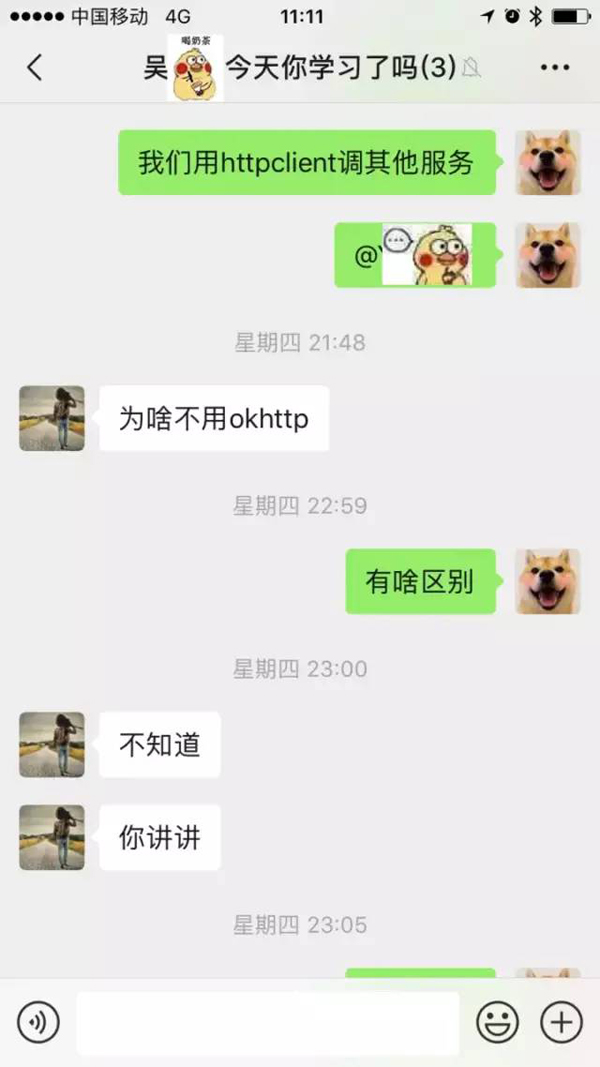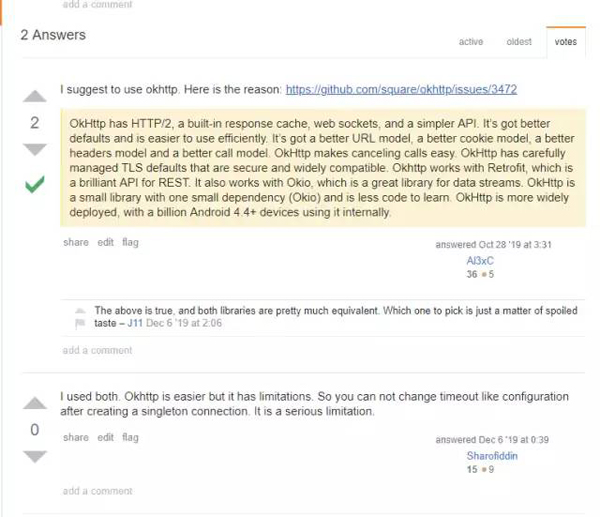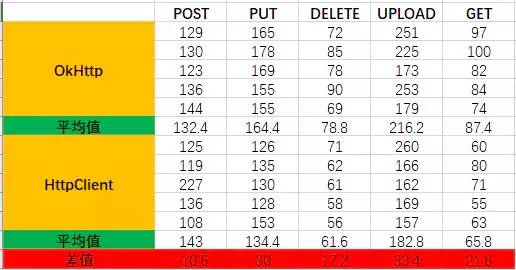HTTP客戶端連接,選擇HttpClient還是OkHttp?
寫在前面
為什么會寫這篇文章,起因于和朋友的聊天
這又觸及到我的知識盲區了,首先來一波面向百度學習,直接根據關鍵字httpclient和okhttp的區別、性能比較進行搜索,沒有找到想要的答案,于是就去overstackflow上看看是不是有人問過這個問題,果然不會讓你失望的
所以從使用、性能、超時配置方面進行比較
使用
HttpClient和OkHttp一般用于調用其它服務,一般服務暴露出來的接口都為http,http常用請求類型就為GET、PUT、POST和DELETE,因此主要介紹這些請求類型的調用
HttpClient使用介紹
使用HttpClient發送請求主要分為以下幾步驟:
- 創建 CloseableHttpClient對象或CloseableHttpAsyncClient對象,前者同步,后者為異步
- 創建Http請求對象
- 調用execute方法執行請求,如果是異步請求在執行之前需調用start方法
創建連接:
- CloseableHttpClient httpClient = HttpClientBuilder.create().build();
該連接為同步連接
GET請求:
- @Test
- public void testGet() throws IOException {
- String api = "/api/files/1";
- String url = String.format("%s%s", BASE_URL, api);
- HttpGet httpGet = new HttpGet(url);
- CloseableHttpResponse response = httpClient.execute(httpGet);
- System.out.println(EntityUtils.toString(response.getEntity()));
- }
使用HttpGet表示該連接為GET請求,HttpClient調用execute方法發送GET請求
PUT請求:
- @Test
- public void testPut() throws IOException {
- String api = "/api/user";
- String url = String.format("%s%s", BASE_URL, api);
- HttpPut httpPut = new HttpPut(url);
- UserVO userVO = UserVO.builder().name("h2t").id(16L).build();
- httpPut.setHeader("Content-Type", "application/json;charset=utf8");
- httpPut.setEntity(new StringEntity(JSONObject.toJSONString(userVO), "UTF-8"));
- CloseableHttpResponse response = httpClient.execute(httpPut);
- System.out.println(EntityUtils.toString(response.getEntity()));
- }
POST請求:
添加對象
- @Test
- public void testPost() throws IOException {
- String api = "/api/user";
- String url = String.format("%s%s", BASE_URL, api);
- HttpPost httpPost = new HttpPost(url);
- UserVO userVO = UserVO.builder().name("h2t2").build();
- httpPost.setHeader("Content-Type", "application/json;charset=utf8");
- httpPost.setEntity(new StringEntity(JSONObject.toJSONString(userVO), "UTF-8"));
- CloseableHttpResponse response = httpClient.execute(httpPost);
- System.out.println(EntityUtils.toString(response.getEntity()));
- }
該請求是一個創建對象的請求,需要傳入一個json字符串
上傳文件
- @Test
- public void testUpload1() throws IOException {
- String api = "/api/files/1";
- String url = String.format("%s%s", BASE_URL, api);
- HttpPost httpPost = new HttpPost(url);
- File file = new File("C:/Users/hetiantian/Desktop/學習/docker_practice.pdf");
- FileBody fileBody = new FileBody(file);
- MultipartEntityBuilder builder = MultipartEntityBuilder.create();
- builder.setMode(HttpMultipartMode.BROWSER_COMPATIBLE);
- builder.addPart("file", fileBody); //addPart上傳文件
- HttpEntity entity = builder.build();
- httpPost.setEntity(entity);
- CloseableHttpResponse response = httpClient.execute(httpPost);
- System.out.println(EntityUtils.toString(response.getEntity()));
- }
通過addPart上傳文件
DELETE請求:
- @Test
- public void testDelete() throws IOException {
- String api = "/api/user/12";
- String url = String.format("%s%s", BASE_URL, api);
- HttpDelete httpDelete = new HttpDelete(url);
- CloseableHttpResponse response = httpClient.execute(httpDelete);
- System.out.println(EntityUtils.toString(response.getEntity()));
- }
請求的取消:
- @Test
- public void testCancel() throws IOException {
- String api = "/api/files/1";
- String url = String.format("%s%s", BASE_URL, api);
- HttpGet httpGet = new HttpGet(url);
- httpGet.setConfig(requestConfig); //設置超時時間
- //測試連接的取消
- long begin = System.currentTimeMillis();
- CloseableHttpResponse response = httpClient.execute(httpGet);
- while (true) {
- if (System.currentTimeMillis() - begin > 1000) {
- httpGet.abort();
- System.out.println("task canceled");
- break;
- }
- }
- System.out.println(EntityUtils.toString(response.getEntity()));
- }
調用abort方法取消請求 執行結果:
- task canceled
- cost 8098 msc
- Disconnected from the target VM, address: '127.0.0.1:60549', transport: 'socket'
- java.net.SocketException: socket closed...【省略】
OkHttp使用
使用OkHttp發送請求主要分為以下幾步驟:
- 創建OkHttpClient對象
- 創建Request對象
- 將Request 對象封裝為Call
- 通過Call 來執行同步或異步請求,調用execute方法同步執行,調用enqueue方法異步執行
創建連接:
- private OkHttpClient client = new OkHttpClient();
GET請求:
- @Test
- public void testGet() throws IOException {
- String api = "/api/files/1";
- String url = String.format("%s%s", BASE_URL, api);
- Request request = new Request.Builder()
- .url(url)
- .get()
- .build();
- final Call call = client.newCall(request);
- Response response = call.execute();
- System.out.println(response.body().string());
- }
PUT請求:
- @Test
- public void testPut() throws IOException {
- String api = "/api/user";
- String url = String.format("%s%s", BASE_URL, api);
- //請求參數
- UserVO userVO = UserVO.builder().name("h2t").id(11L).build();
- RequestBody requestBody = RequestBody.create(MediaType.parse("application/json; charset=utf-8"),
- JSONObject.toJSONString(userVO));
- Request request = new Request.Builder()
- .url(url)
- .put(requestBody)
- .build();
- final Call call = client.newCall(request);
- Response response = call.execute();
- System.out.println(response.body().string());
- }
POST請求:
添加對象
- @Test
- public void testPost() throws IOException {
- String api = "/api/user";
- String url = String.format("%s%s", BASE_URL, api);
- //請求參數
- JSONObject json = new JSONObject();
- json.put("name", "hetiantian");
- RequestBody requestBody = RequestBody.create(MediaType.parse("application/json; charset=utf-8"), String.valueOf(json));
- Request request = new Request.Builder()
- .url(url)
- .post(requestBody) //post請求
- .build();
- final Call call = client.newCall(request);
- Response response = call.execute();
- System.out.println(response.body().string());
- }
上傳文件
- @Test
- public void testUpload() throws IOException {
- String api = "/api/files/1";
- String url = String.format("%s%s", BASE_URL, api);
- RequestBody requestBody = new MultipartBody.Builder()
- .setType(MultipartBody.FORM)
- .addFormDataPart("file", "docker_practice.pdf",
- RequestBody.create(MediaType.parse("multipart/form-data"),
- new File("C:/Users/hetiantian/Desktop/學習/docker_practice.pdf")))
- .build();
- Request request = new Request.Builder()
- .url(url)
- .post(requestBody) //默認為GET請求,可以不寫
- .build();
- final Call call = client.newCall(request);
- Response response = call.execute();
- System.out.println(response.body().string());
- }
通過addFormDataPart方法模擬表單方式上傳文件
DELETE請求:
- @Test
- public void testDelete() throws IOException {
- String url = String.format("%s%s", BASE_URL, api);
- //請求參數
- Request request = new Request.Builder()
- .url(url)
- .delete()
- .build();
- final Call call = client.newCall(request);
- Response response = call.execute();
- System.out.println(response.body().string());
- }
請求的取消:
- @Test
- public void testCancelSysnc() throws IOException {
- String api = "/api/files/1";
- String url = String.format("%s%s", BASE_URL, api);
- Request request = new Request.Builder()
- .url(url)
- .get()
- .build();
- final Call call = client.newCall(request);
- Response response = call.execute();
- long start = System.currentTimeMillis();
- //測試連接的取消
- while (true) {
- //1分鐘獲取不到結果就取消請求
- if (System.currentTimeMillis() - start > 1000) {
- call.cancel();
- System.out.println("task canceled");
- break;
- }
- }
- System.out.println(response.body().string());
- }
調用cancel方法進行取消 測試結果:
- task canceled
- cost 9110 msc
- java.net.SocketException: socket closed...【省略】
小結
OkHttp使用build模式創建對象來的更簡潔一些,并且使用.post/.delete/.put/.get方法表示請求類型,不需要像HttpClient創建HttpGet、HttpPost等這些方法來創建請求類型
依賴包上,如果HttpClient需要發送異步請求、實現文件上傳,需要額外的引入異步請求依賴
- <!---文件上傳-->
- <dependency>
- <groupId>org.apache.httpcomponents</groupId>
- <artifactId>httpmime</artifactId>
- <version>4.5.3</version>
- </dependency>
- <!--異步請求-->
- <dependency>
- <groupId>org.apache.httpcomponents</groupId>
- <artifactId>httpasyncclient</artifactId>
- <version>4.5.3</version>
- </dependency>
請求的取消,HttpClient使用abort方法,OkHttp使用cancel方法,都挺簡單的,如果使用的是異步client,則在拋出異常時調用取消請求的方法即可
超時設置
HttpClient超時設置:
在HttpClient4.3+版本以上,超時設置通過RequestConfig進行設置
- private CloseableHttpClient httpClient = HttpClientBuilder.create().build();
- private RequestConfig requestConfig = RequestConfig.custom()
- .setSocketTimeout(60 * 1000)
- .setConnectTimeout(60 * 1000).build();
- String api = "/api/files/1";
- String url = String.format("%s%s", BASE_URL, api);
- HttpGet httpGet = new HttpGet(url);
- httpGet.setConfig(requestConfig); //設置超時時間
超時時間是設置在請求類型HttpGet上,而不是HttpClient上
OkHttp超時設置:
直接在OkHttp上進行設置
- private OkHttpClient client = new OkHttpClient.Builder()
- .connectTimeout(60, TimeUnit.SECONDS)//設置連接超時時間
- .readTimeout(60, TimeUnit.SECONDS)//設置讀取超時時間
- .build();
小結:
如果client是單例模式,HttpClient在設置超時方面來的更靈活,針對不同請求類型設置不同的超時時間,OkHttp一旦設置了超時時間,所有請求類型的超時時間也就確定
HttpClient和OkHttp性能比較
測試環境:
- CPU 六核
- 內存 8G
- windows10
每種測試用例都測試五次,排除偶然性
client連接為單例:
client連接不為單例:
單例模式下,HttpClient的響應速度要更快一些,單位為毫秒,性能差異相差不大
非單例模式下,OkHttp的性能更好,HttpClient創建連接比較耗時,因為多數情況下這些資源都會寫成單例模式,因此圖一的測試結果更具有參考價值
總結
OkHttp和HttpClient在性能和使用上不分伯仲,根據實際業務選擇即可
示例代碼
https://github.com/TiantianUpup/http-call

































